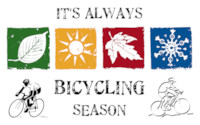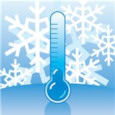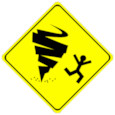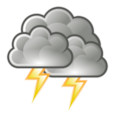 Kansas has a temperate climate, with four true and distinct seasons. With temperature swings from -10deg;F or so in the dead of a winter night, to 100+°F on a hot summer day, and inclement weather that may include rain, snow, hail, sleet, fog, wind, and the famous Kansas tornadoes, camping can definitely be a challenge at times.
Kansas has a temperate climate, with four true and distinct seasons. With temperature swings from -10deg;F or so in the dead of a winter night, to 100+°F on a hot summer day, and inclement weather that may include rain, snow, hail, sleet, fog, wind, and the famous Kansas tornadoes, camping can definitely be a challenge at times.
Of course, the vast majority of the time, the weather is quite pleasant, and camping is fun, easy, and safe.
Camping in Kansas is possible year-round, given the proper equipment, preparation, and attitude. Each season or weather condition requires some degree of specialization, and no one setup will meet all needs and all conditions. Finding the gear that works for you is what this article will try to cover.
Heat
 Summers in Kansas can be a challenge, both in terms of temperature and humidity. At its worst, daytime temperatures can reach over 100+°F with high humidity, and darkness does not always bring relief, with nighttime temperatures still in the 80s, and humidity still stiflingly high. Sometimes a tent can feel like a sauna.
Summers in Kansas can be a challenge, both in terms of temperature and humidity. At its worst, daytime temperatures can reach over 100+°F with high humidity, and darkness does not always bring relief, with nighttime temperatures still in the 80s, and humidity still stiflingly high. Sometimes a tent can feel like a sauna.
It's at times such as this that you'll appreciate a tent with adequate ventilation, preferably lots of mesh to keep out the bugs, and a detachable rainfly to maximize airflow. A summer-weight sleeping bag (55°F or so) is also a good choice for most of the last Spring, Summer, and early Autumn.
Of course, heat-related illnesses are always a concern. Become familiar with the warning signs of heat stress, heat exhaustion, and heat stroke, and learn how to protect yourself.
Cold
 Winters in Kansas can very from exceedingly mild to downright frigid. There is typically at least one stretch, usually in late January or February, where the temperature does not rise about 100+°F during the day, with sub-zero temps at night, often accompanied by a howling, icy wind.
Winters in Kansas can very from exceedingly mild to downright frigid. There is typically at least one stretch, usually in late January or February, where the temperature does not rise about 100+°F during the day, with sub-zero temps at night, often accompanied by a howling, icy wind.
Snow, like temperatures, can vary greatly from one year to the next. Some winters have almost no snow, while a foot or two of the white stuff can pile up other years. Blizzards, with "white-out" road conditions, are not uncommon.
Camping in these kinds of conditions can certainly be done, but requires a good deal of foresight, and the right equipment. It can be quite hazardous as well.
If you happen to be traveling through Kansas during the winter, and are caught out in times like this, hotels are strongly recommended, unless you're thoroughly prepared for the conditions. If you're intent on riding and camping through this weather, some of the advice at icebike.org and wintercampers.com might prove useful.
Tornadoes
 Kansas is infamous for its tornado activity, due to its location in the heart of "tornado alley". Typically over 100 strike the state annually, most often occurring from mid-April through mid-June.
Kansas is infamous for its tornado activity, due to its location in the heart of "tornado alley". Typically over 100 strike the state annually, most often occurring from mid-April through mid-June.
Most communities in the state have comprehensive emergency weather systems, including tornado sirens and storm shelters, and radio and television stations always provide exhaustive coverage of any severe weather threat.
It is advisable to carry a weather radio, and to be aware of your options should dangerous weather pop up. If you need to seek shelter, ask a local resident – they'll direct you to the nearest public shelter. Do not remain in your camp during tornado warnings – your tent is no match for the devastation a tornado can bring.
If you're camping in a remote area, be extra careful. Trees offer no real protection during a storm, and can often pose more of a danger than open ground. The Storm Prediction Center offers this advice: "In the open outdoors: If possible, seek shelter in a sturdy building. If not, lie flat and face-down on low ground, protecting the back of your head with your arms. Get as far away from trees and cars as you can; they may be blown onto you in a tornado."
Thunderstorms
 Although most storms are relatively mild, Kansas does have its share of severe storms, which can include wind, rain, thunder and lightning.
Although most storms are relatively mild, Kansas does have its share of severe storms, which can include wind, rain, thunder and lightning.
Beyond the challenges wind can make for bicycling, wind can make it difficult to camp as well, requiring extra time and precautions to ensure that your tent is securely staked to the ground. Don't camp near trees in windstorms, due to the danger of falling limbs.
Don't camp in low-lying areas that may be prone to flooding or collecting standing water. It's quite discouraging to wake in the morning to find that your tent is an island surrounded by several inches of water and debris. If you're lucky, you'll be able to pack up the tent and move along (hopefully spreading the tent to dry once sunlight returns). If you're unlucky, your tent won't be waterproof, and you and all your gear will be soaked.
Lighting can be a danger when camping outdoors, whether on the open prairie or surrounded by trees. The National Weather Service offers this advice: "If camping, hiking, etc., far from a safe vehicle or building, avoid open fields, the top of a hill or a ridge top. Stay away from tall, isolated trees or other tall objects. If you are in a forest, stay near a lower stand of trees. If you are camping in an open area, set up camp in a valley, ravine or other low area. Remember, a tent offers NO protection from lighting." (But don't go into too low of an area; be aware of the possibility of flash-flooding.)


